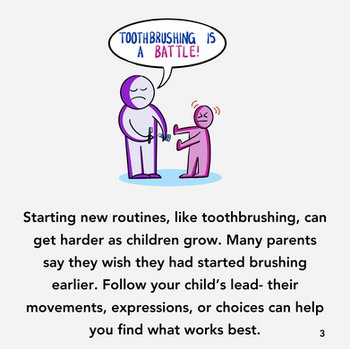
Non-flavoured and non-foaming toothpaste
Overview
Many toothpastes foam up when you brush, and this is because of an ingredient called Sodium Lauryl Sulfate (SLS). For children with sensory sensitivities, this foaming can be uncomfortable. If your child does not like traditional mint toothpaste, consider choosing one with a different flavour or even one with no flavour at all. Often, toothpastes that are SLS-free are milder in flavour.
Recommended by parents
Some toothpastes can feel too strong or foamy, especially for people with sensory sensitivities. That’s why many families use special toothpastes like OraNurse, which doesn’t foam and has no taste. It’s made to be gentle for people who find brushing tricky.
Other gentle toothpastes include OraLieve, Biotene, and some Sensodyne options. These don’t foam much and have mild or no flavour. Lots of parents have told us they use OraNurse, but it can be a bit pricey.
Top Tip
If you search online for “SLS-free toothpaste”, you’ll find many good choices. These are often used by people with sore mouths or dry mouths, so they’re made to be soothing and comfortable.
What to look out for
It’s important to use toothpaste with the right amount of fluoride to help protect teeth. Check the label on the tube, it should say 1350 to 1500 ppm fluoride (most adult toothpastes have this). If the fluoride level is right, the toothpaste is safe to use for both children and adults. Make sure to watch your child while they brush, to help them use the right amount and to make sure they don’t swallow the toothpaste like food.
For some autistic children, non-flavoured and non-foaming toothpaste can be useful if:
Your child is sensitive to strong flavours
For many autistic children, the mint flavour of toothpaste is too strong. Many complain of a burning or stinging sensation. Many toothpastes are available with either less of a mint taste or a different flavour altogether. This type of toothpaste has been designed to be mild flavour or flavour-free. These types of toothpaste can offer a gentle introduction to toothbrushing, reducing the potential for discomfort, pain and sensory overload.
There are also flavoured toothpaste described above that may helpful if your child prefers milder flavours.
Your child does not like the foaminess of the toothpaste
This is because this toothpaste is Sodium-Laurel-Sulphate (Sulfate) free. Sodium-Laurel-Sulphate (Sulfate) causes the foaminess of the toothpaste. You might find your child prefers toothpaste such as OraNurse because it does not foam in the mouth.
Your child does not like the look of their toothpaste
Some children have told us they do not like the look of their toothpaste when it ‘bubbles’. Some toothpaste such as OraNurse contains no artificial colours and does not foam.
How to apply toothpaste
Here’s a visual guide from Mini Mouth Care Matters on how to apply toothpaste correctly. This is part of a wider set of resources for professionals working in Special Education Settings. Further information is available here.
Key messages

Watch again
Jump straight to what parents and early years professionals have said about different types of toothpaste.





